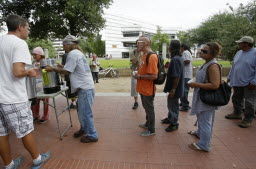Whether homeless rates are improving in Pima County and Arizona depends on your definition.
The U.S. Department of Housing and Urban Development released its latest findings last week, providing the nation and Arizona with a snapshot of homelessness based on surveys conducted here and nationwide one night last January.
Their findings look good — and that’s what scares some local and national advocates for the homeless, especially when it comes to the needs of youth, and of children and families.
Since 2010, HUD found a 28 percent reduction in homelessness in Arizona, with a 6 percent drop from 2014 to 2015, said Ed Cabrera, regional public affairs officer for HUD in San Francisco. Tucson and Pima County saw a 39 percent reduction since 2010, he said, with a 15 percent drop from 2014 to 2015.
Nationwide, homelessness has decreased 11 percent since 2010, he said, with a 36 percent decrease among veterans.
The snag, said Youth on their Own’s executive director Teresa Liverzani-Baker, is that tracking the homeless differs depending on who is participating.
HUD looks at street counts, she said, which includes people who are living outside in parks, under bridges or in shelters. HUD doesn’t include families and children who are living in cars, doubling up in rented hotel rooms or temporarily sleeping on a friend’s floor.
Census data in 2013 showed 5,800 homeless youth in Pima County, Liverzani-Baker said, while current local estimates are now around 9,000.
In 2010, HUD started Opening Doors, a federal strategic plan to prevent and end homelessness. So far, the focus has been on homeless veterans and adults who are chronically homeless. Cabrera said HUD needs to improve on its data collection on youth homelessness.
The U.S. Department of Education is reporting an increase of about 6 percent nationwide for homeless children and their families, said Barbara Duffield, policy director for the National Association for the Education of Homeless Children and Youth. There has been a 100 percent increase nationally since the 2006 school year, she said.
“It’s very damaging when the HUD numbers come out and they don’t accurately reflect what’s happening,” she said. “It makes it that much harder for schools and organizations to educate the public on the needs of these children, teens and their families.”
In recent years, Cabrera said, HUD has started looking at U.S. Department of Education numbers on families and children who are homeless or marginally housed in order to improve on services for those families.
He agrees their count does not represent “every person or family eligible for services.”
Peggy Hutchison, chief executive officer of Primavera, said to help more people, her organization and Our Family Services started a program called Pathways Home in December 2013. The state-funded program coordinates assessment and placements for those at highest risk.
Between Dec. 1, 2013 and mid-June 2015, she said, just under 3,000 people sought help due to homelessness, and about 50 percent of those were people with families. She said Primavera had to turn away about 58 percent of those seeking help due to insufficient resources.
On average, said Patti Caldwell, executive director of Our Family Services, it costs less than $2,000 to help a family get off the street and into stable housing.





